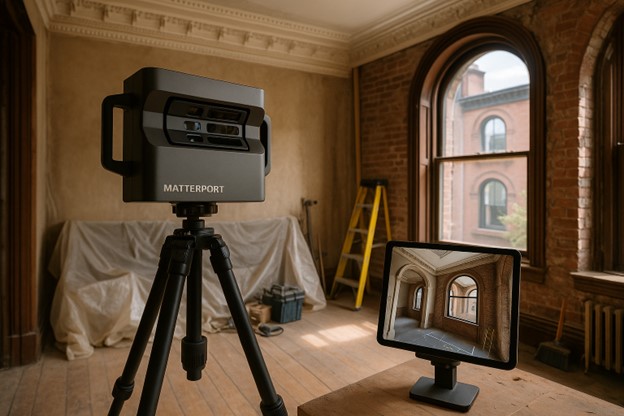Digital measurement systems have reshaped how contractors document work within Boston’s historic preservation framework. Chris Rapczynski, who founded and leads Sleeping Dog Properties, has integrated Matterport scanning technology across construction projects worth $500 million since launching his firm in 1993. His adoption of 3D scanning tackles measurement precision challenges that traditional methods cannot resolve in protected architectural districts.
Spatial documentation has grown globally, with Matterport reporting management of 50.7 billion square feet, showing 33% annual growth. Construction firms face stricter documentation requirements when working near protected structures, including projects adjacent to landmarks like the Massachusetts State House or within Boston’s federally designated historic neighborhoods where preservation authorities demand comprehensive existing condition records.
“I think we use a product called Matterport, which is a scanning document that scans a house,” Rapczynski explained during a recent interview. “When we go to do a measurement, we scan the house, and then that LIDAR scanning, radio scanning… does the measurements for me so that I know the wall placements.” Precision becomes critical when renovation proposals undergo review by architectural commissions overseeing buildings from Boston’s colonial and federal periods.
Sleeping Dog Properties has completed work ranging from high-rise residential units in Millennium Tower to medical facilities in Newton and restaurant construction in Andover. General Contractors Magazine recognized the firm among notable Cambridge contractors in 2022, reflecting industry acknowledgment of documentation methods.
Compliance Documentation for Protected Structures
Preservation violations create expensive remediation requirements, generating financial risk for contractors working within historic districts. Regulatory oversight increases when modifications affect structures listed on the National Register of Historic Places or subject to local landmark designation. Architectural review boards throughout Boston require detailed documentation of existing conditions before approving alteration permits.
Digital scanning produces timestamped records establishing baseline conditions prior to construction activity. Documentation requirements differ by district, with neighborhoods like Beacon Hill and Back Bay requiring more comprehensive records due to their concentration of 18th and 19th-century architecture. Review boards examine proposed modifications against these baseline records to ensure preservation compliance.
Matterport technology has documented structures across 177 countries, supporting construction lifecycle management from initial planning through operational phases. Equipment costs have decreased relative to specialized surveying instruments, which can exceed $20,000 for comparable precision capabilities.
Quality verification extends beyond initial measurements to construction monitoring. “When we build something and we have the baseline model, I can scan the house again with Matterport, and it can tell me if I’ve built it to the plans,” Rapczynski noted. Verification processes help identify construction deviations during work phases rather than after completion, when corrections require additional permitting and coordination with preservation authorities.
Remote project oversight capabilities emerge through virtual site documentation. “As a construction manager, I love the Matterport, which is this VR technology because it gives me a virtual 3D walkthrough when we scan the place. And that allows me not to have to be on site, and I can go and look and stuff,” Rapczynski explained. Multi-site project management becomes feasible without physical presence at each location across Greater Boston’s dispersed work sites.
Post-Construction Problem Resolution
Timestamped documentation provides diagnostic capabilities when problems emerge after project completion. Historical record-keeping enables contractors to isolate problem sources through chronological analysis of construction phases. “On July 19th, this is what this looked like. And it’s totally fine there, and now there’s water pouring out of here so we know it can’t be this and it might be this,” Rapczynski described regarding troubleshooting methodology.
Historic structures throughout Cambridge and Boston’s South End contain mechanical systems installed through multiple renovation periods, creating complex infrastructure networks within original structural frameworks. Buildings like Fenway Park, constructed in 1912, demonstrate how historic facilities require specialized documentation for ongoing maintenance and modification work. Digital records document system installations and their relationships to existing building components.
Insurance claims and warranty disputes benefit from comprehensive installation documentation and system performance records. High-value renovation projects in Newton and Brookline neighborhoods involve substantial client investments requiring detailed contractor accountability through systematic documentation protocols.
Market Adoption and Technical Integration
CoStar Group’s pending $2.1 billion acquisition of Matterport signals institutional recognition of digital twin technology’s commercial potential. Platform consolidation reflects growing adoption of spatial documentation systems across real estate and construction sectors.
Client expectations have shifted toward digital documentation capabilities, particularly for high-value historic preservation projects where traditional measurement methods prove insufficient for complex regulatory requirements. Early technology adoption has positioned firms to meet documentation standards that have transitioned from specialized services to standard practice expectations.
LIDAR scanning enables spatial analysis applications essential for complex renovation work. Rapczynski employs technology to identify structural voids, wall thicknesses, and concealed building systems that conventional measurement cannot detect. “It can help me find the voids. If a wall’s five-and-a-half inches thick, it might help me tell that,” he explained. Analytical capabilities become crucial when integrating contemporary mechanical systems into historic structures while maintaining architectural integrity.
Space limitations in high-end residential projects require precise documentation for system integration. “In a very sophisticated larger scale, high-end residential home, there’s not a lot of space. So we wind up having to make a lot of accommodations, which just costs time,” Rapczynski observed. Digital documentation helps optimize space utilization while maintaining preservation compliance requirements.
Technology Limitations and Sector Implications
Matterport scanning currently functions as an office-based tool rather than providing real-time field verification. “It’s still an office tool that’s used in the field, and I wish it were a field tool that we all relied on. Anytime something is built, you hit a button and check in and scan the document, whether something’s wrong or not,” Rapczynski explained. Processing requirements create delays between data capture and analysis, limiting immediate quality control during construction phases.
Construction industry data indicates the sector achieved $1.27 trillion in 2024, representing 5.6% growth from the previous year. Digital documentation systems address workforce shortages while maintaining quality standards, particularly in specialized markets like historic preservation where regulatory compliance demands precise record-keeping.
Current technology limitations mean that scanning systems still function more as office-based analysis tools rather than immediate field verification resources, creating delays between capturing data and getting actionable feedback during active construction phases. Since establishing his firm, Rapczynski has rolled out these scanning protocols across projects throughout Massachusetts, New Hampshire, and Cape Cod markets, with the combined work representing approximately $500 million in construction value.
Published in: Real estate | Author: Lynn







